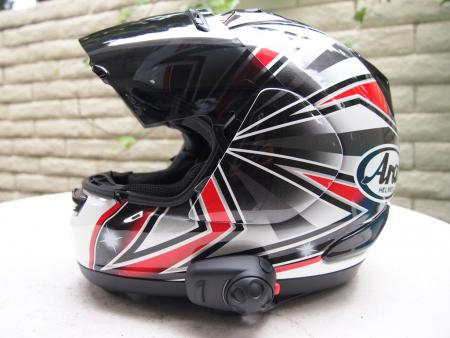Sena SMH5 Communicator Review
Last year we evaluated Sena’s SMH10 Bluetooth headset and came away impressed for a number of reasons. It allows communication with up to three different headsets, has a range of up to 900 yards, and comes with a host of accessories.
On the downside, a single unit retails for $219, high enough to put it out of reach for many riders. And if you want to talk to another rider or your passenger, you’ll have to shell out a dollar shy of 400 big ’uns for a two-unit set.
In response, Sena has introduced the SMH5 communicator system, a few-frills version of the SMH10, coming in almost a C-note cheaper at $129 for a single unit. A dual pack comes in at $249 and allows for two-person communication over a shorter range than the SMH10.
The SMH5 uses the latest Bluetooth v3.0 technology instead of the new-at-the-time v2.1 protocol installed in the SMH10 we tested in 2011. The latest SMH10 also uses v3.0, which allows faster data transfer rates. It’s compatible with Bluetooth devices such as phones, GPS and music players.
Both the 5 and 10 are firmware upgradable, have volume controls for each audio source, voice command playback control, versatile jog dial, use while charging (cigarette lighter charger sold separately for SMH5), Bluetooth stereo music and an audio booster.
However, there’s a reason the SMH5 is less expensive. For starters, the 5 has a claimed intercom talk distance of up to 400 meters (437 yards), compared to the 10’s 900-meter (980-yard) range. Talk time is reduced to eight hours with seven days standby time for the lesser model, while the premier unit boasts 12 hours and 10 days, respectively.
Fewer accessories also factor into the lower price tag. Inside the SMH5’s box are the essential items to get started: main headset unit, helmet clamp, speakers, boom microphone, USB power cable, and an assortment of Velcro pads and sponges. The SMH10 takes this one step further by including a DC power charger, 3.5mm audio cable for non-Bluetooth enabled audio devices, microphone cap, the aforementioned cigarette lighter charger and more.
Differences aside, the SMH5 is still an admirable performer. Compared to the SMH10, whose mic is hard-wired into the helmet clamp unit, the SMH5 is modular in that the speakers and mic are wired into the main unit via male/female connectors.
It’s imperative to ensure each connector is secured in place for proper operation. We struggled for hours troubleshooting why one unit could perform every function except recognize voice commands. The answer was a slightly loose connection into the main unit. After snugging the connection the unit worked flawlessly.
The included boom microphone is better suited towards modular or three-quarter helmets, although it can also cleanly fit full-face lids. But Content Editor Tom Roderick advises purchasing the wired mic for use in FF helmets. “It’s only eight bucks and operates as good as the boom microphone without the hassle of configuring the boom mic to fit inside a full-face helmet.”
T-Rod also was impressed with the simple operation via just two buttons, proving easy to manipulate with gloved hands. An included quick-start guide is straightforward and will get you on your way in minutes. Simply put, the red button at the rear of the unit handles phone functions while the large jog dial handles volume, intercom and music functions. Different sequences perform different functions and are clearly defined in the guide.
Volume from the speakers is more than adequate when riding without earplugs, as the SMH5 features an audio booster, automatically raising the audio level according to ambient wind noise. However, the unit must be at full volume in order to hear phone conversations with ear plugs in. That said, most comm sets we’ve sampled require max volume to cut through ear plugs. Otherwise, sounds coming from the SMH5 are “impressive for such an inexpensive device with small speakers,” Tom says.
We’re not big fans of making or taking phone calls while riding, but the SMH5’s Bluetooth connectivity to your phone sure can come in handy (assuming your phone is also Bluetooth compatible). Tap the red Phone button, clearly state the number to call, and the phone/Bluetooth does the rest. During our calls, both parties had no complaints about audio quality. Inherent wind noise, which is simply unavoidable, is present but doesn’t interrupt the conversation. Same goes for intercom communication as well.
By far the SMH5’s weakest point is usable range when paired with a rider on another bike. While riding in a major metropolitan area with tall buildings, intercom connectivity between our riders failed when we were separated by two city blocks. This despite being in clear view of one another. Range dropped further when one of us turned a corner and line-of-sight was blocked by a building.
Range picked up slightly on the open road, as intercom connectivity extended to approximately one quarter mile (400 meters) as advertised. When skirting on the edge of intercom range, a small rise in elevation blocked line-of-sight and was enough to temporarily interrupt our intercom communication.
Still, considering its sound quality while within range, we can’t help but be thoroughly impressed with the SMH5 when taking its price point into play. It performs its several Bluetooth functions simply and it’s quite affordable. And, as Tom notes, “For the price, the Sena SMH5 is the perfect intercom set for rider-to-passenger communication,” as range limitations are a non-issue.
If rider-to-rider communication is a priority, the SMH10’s longer range and stronger battery is the way to go. But if you’re mostly interested only in connecting to phones or music players (or a passenger behind you), the SMH5 is a nicely priced and well-designed system.
For more information on the SMH5, along with Sena’s other offerings, visit http://www.senabluetooth.com/.
Related Reading
Sena SMH10 Bluetooth Headset and Intercom Review
Cardo Scala Rider Q2 Bluetooth Communicator Review
More by Troy Siahaan


































Comments
Join the conversation